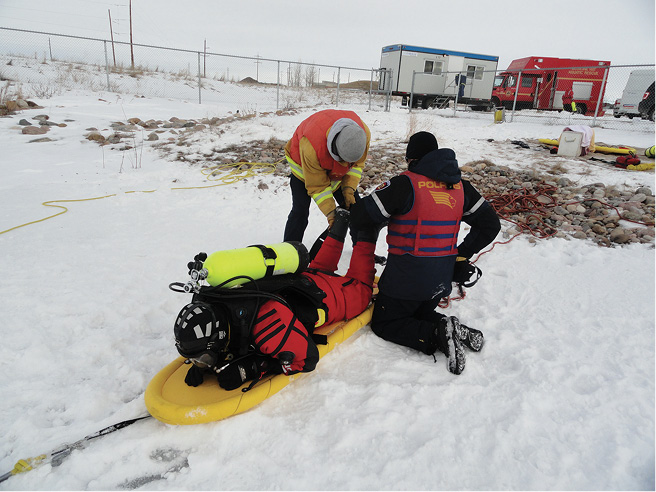
BY WALTER “BUTCH” HENDRICK
With ice rescue season right around the corner, it’s time to break out the ice rescue equipment for surface and subsurface operations to make sure it made it through the summer months, that the mice haven’t eaten holes in our suits, that the ropes/lines aren’t frayed, and that all the equipment is still ready to go. We must also ensure that we are still proficient in using these tools. Departments that want to be ready to conduct surface and subsurface ice rescue/recovery operations must set up a training schedule so the members of the ice rescue team can reacquaint themselves with the proper use of the equipment and all the proper safety procedures required for ice operations. As November passes, so does the time window for preparation, training, and the budget to replace any ice rescue equipment as needed.
Ice Rescue Operations
Too often, we don’t train for the real world. As seen in many failed ice rescue/recovery attempts, rescuers often don’t fully understand the reality of an ice rescue call.
ALSO
FALL PREPLANNING FOR SAFE ICE RESCUE OPERATIONS, PART 1
FALL PREPLANNING FOR SAFE ICE RESCUE OPERATIONS, PART 2
FALL PREPLANNING FOR SAFE ICE RESCUE OPERATIONS, PART 3
The Use of Airboats in Ice and Water Rescue Emergencies
Consider 100 feet of weak ice through which a 35-pound dog has fallen or that is not strong enough to support a 10-year-old’s weight (about 70 pounds). The fatigue resulting from crossing that 100 feet of ice can be physically equivalent to 20 minutes of cross-training every muscle in your body. Although you’re warm because you are wearing proper personal protection equipment (PPE), your forearm muscles begin to cramp and your hands can no longer properly hold onto or use your ice awls. Your breathing is overstressed, and just inhaling may be a monumental project.
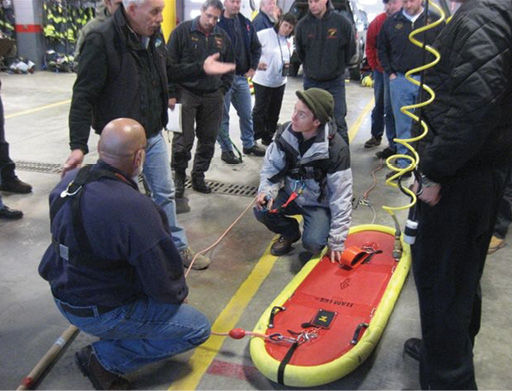
(1) Surface ice rescuers from the Bayport (NY) Fire Department and other departments sketch and write out the procedures for the TeamLGS surface ice rescue leapfrogging rigging system after learning how to set it up and use it during land exercises. (Photos 1-5 by author.)
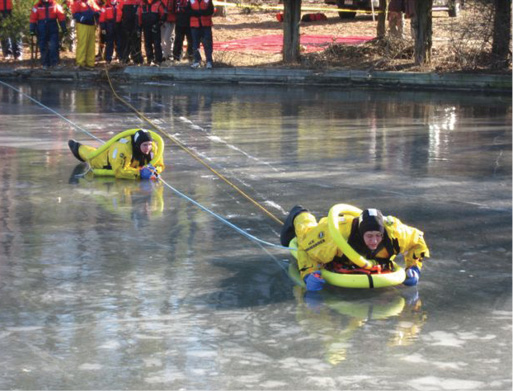
(2) Tech 1 (left) rests on the ice, still connected into the system, while a fresh tech 2 (right) progresses toward the victims. Operations shore personnel control the in and out lines.
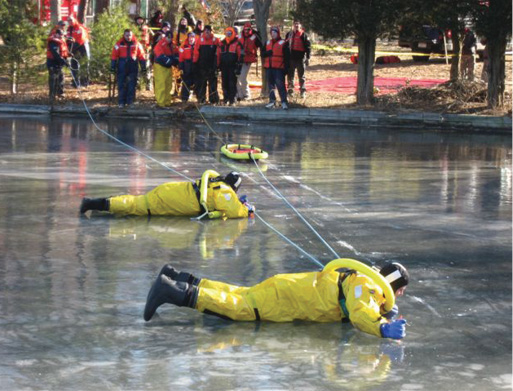
(3) Surface ice rescue tech 2 (right) pretends to be fatigued and becomes a human ice screw while the shore pulls the sled to shore to pick up a fresh tech 3. In an operation, technicians could be more than 100 feet apart depending on the condition of the ice. Tech 3 is pulled to tech 2 by shore personnel.
As an industry, we all too often rely on a single rescuer to be able to complete the rescue mission. When that member cannot reach the victim or complete the task because of fatigue or for any other reason, we pull the would-be rescuer back to shore and start all over again with a new would-be rescuer. Or, in a scenario seen again and again over the years, teams send two technicians out simultaneously, and both lose the ability to efficiently or effectively reach the victims in a timely manner.
We need to learn how to replace rescuers on the ice, in the water, or wherever they are and not lose whatever ground we have gained in aggressively forging ahead to perform a contact rescue. We must better understand what ice rescue is all about. Imagine you are the would-be victim observing as his hopeful rescue fails. Surface ice rescue training can begin on the ground, in the snow, in a dirt field, or even on the apparatus floor. Training shore-based support personnel in assisting the would-be rescuer often is not part of training.
The reality of poor ice often eludes all of us until the reality and failure scream in the back of the brain, telling us there has to be another way. For a thousand years, rescuers around the world have improved as they reevaluated failure.

(4) Tech 3 switches places with tech 2 so that tech 3 can progress forward toward the victim. All techs remain connected into the system so that they can be retrieved should anything go wrong.

(5) The TeamLGS leapfrogging procedures are used for multivictim and multihole operations since they allow technicians to apply immediate-independent-victim-positive-buoyancy (IIVPB) to all victims in a very short period of time. The triage sequence on which victims are treated with IIVPB procedures is the TeamLGS ASAPS (aggressive, self-rescue capable, alert, passive, submerging) diagnosis. As the next tech is pulled out to relieve the previous tech, the latter tech should maintain communication with the victims. The next tech should replay the tech-switching procedures in his mind’s eye during transport to help ensure that it works smoothly.
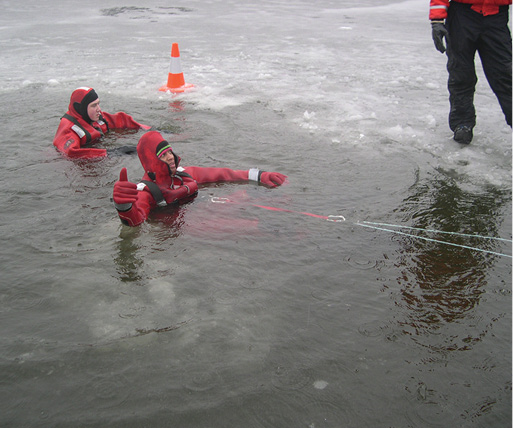
(6) Technicians can serve as ice screws in open water when the ice has been destroyed as long as they have good fins and effective training in kicking. (Photos 6-9 by Andrea Zaferes.)
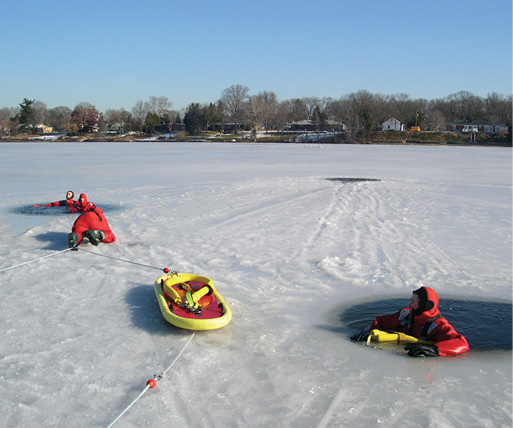
(7) Multivictim, multihole training using the TeamLGS leapfrogging procedures. The tech passed the flotation sling to a self-rescue capable victim while moving rapidly to alert victims who are higher priority on the victim triage scale.

The solution to reaching victims across long distances or on fragile ice, both of which are fatiguing, is a series of TeamLGS leapfrogging procedures that have been proven to work for surface ice rescuers, airboat operations, and subsurface dive team operations.
The problem of long distance, thin ice, or otherwise challenged ice operations affects not only surface ice rescue teams but also public safety dive (PSD) teams that often have more difficulties as they have to transport divers wearing dive equipment that weighs more than 60 pounds.
Difficulty of Subsurface/Ice Diving Procedures
Ice diving teams must understand that if a 10-year-old has fallen through the ice and has submerged to the bottom, the reality is that you can’t walk out there wearing 80 pounds of dive equipment. More often than not, you can’t even crawl. You can’t stand and tend like sport divers. You can’t sit on the ice by the victim point of entry (VPOE) or the victim point of descent (VPOD). If we actively look, the reality of the difficulties in ice rescue is blatantly obvious: Divers are going to have a more difficult time than surface rescue personnel.
It’s not recovering the victim’s body that is difficult, since we often have an exact last seen point, namely the ice hole. This may be true if surface rescuers did not destroy the ice, documented the victim’s location on a profile map with triangulation or site alignment procedures, or left a marker in the original hole’s location. The true difficulties are getting to the hole and being able to descend to the recovery point. We know that in nonmoving water environments, the victim’s body will usually be found in a circle on the bottom below the VPOD with a radius equal to the depth more often than not, within 10 feet from the descending point of the diver in water that’s not too deep.
Ice rescue companies do not need an army of ice divers; they need an exceptionally well-trained surface rescue team that can safely and efficiently transport two to three certified PSD ice divers and two to three certified PSD ice-diving tenders to the VPOD. The team needs these technician-level ice-diving tenders to be capable of safely tending while lying face down on poor ice or perhaps even while being submerged to their shoulders in water surrounded by broken, very weak ice.
Remember, walking, standing, or sitting on the ice is not PSD ice diving; it is sport ice diving. Surface ice rescue and PSD ice operation successes and failures have demonstrated this reality hundreds of times over.
(8) Operations personnel from the Medicine Hat (Alberta, Canada) Fire Department put fins on a backup diver who will be transported to the dive hole and await primary and backup tenders with the use of the leapfrogging procedures.
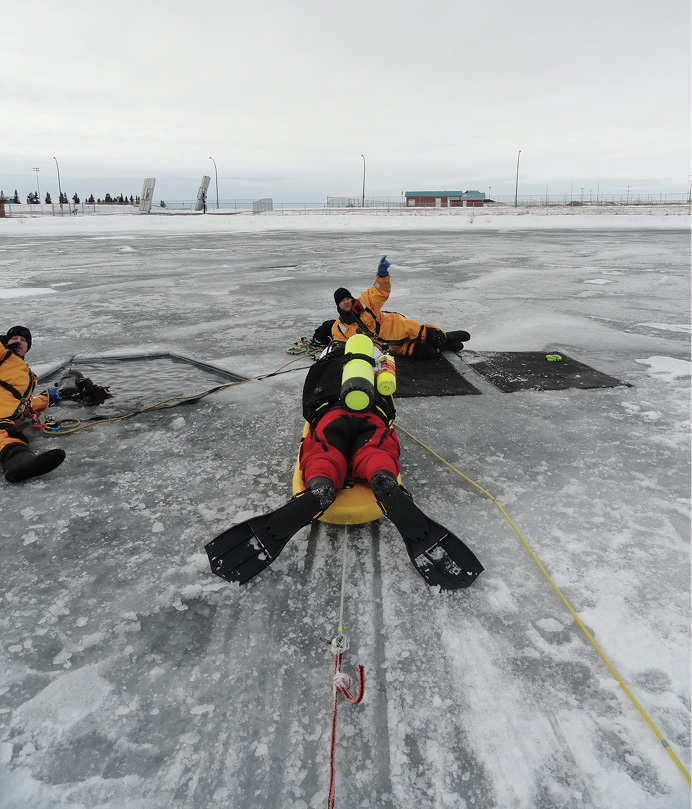
(9) Surface ice rescue operations personnel were a key part of getting the PSD dive team divers and tenders out to the deployment hole. The primary tender (left), the diver, and the backup tender (right) are all connected into the leapfrogging system.
Leapfrogging
The leapfrogging solution uses a pulley system on technicians who deploy on an ice rescue sled. The first technician (tech 1) deploys with the necessary immediate independent victim-positive buoyancy and PPE equipment on the sled and progresses as far as is efficiently possible. Tech 1 slides off the sled and becomes a human ice screw, using ice awls or fins and signals for shore to pull the sled back so tech 2 can get on the sled. The shore team pulls tech 2 out to tech 1. Tech 2 arrives at tech 1 in a rested state ready to progress to the next distance.
If tech 2 cannot reach the victim, there are two options. If tech 1 is sufficiently rested, then that rescuer can replace tech 2 and progress forward. If this is not the case, then shore operations personnel can pull the sled back to the shore and tech 3 boards the sled. The shore team pulls tech 3 to tech 2. Then tech 3 switches places with tech 2, and tech 3 proceeds to the victim. All technicians on the ice are connected into the system with mini pulley strap systems or aluminum carabiners on their ice/dive harnesses, depending on what role they are playing in the operation (resting on the ice or progressing to the victim).
PSD teams that will deploy on thin ice need this equipment and these procedures to get the primary tender, the backup tender, the backup diver, and the primary diver to an opening in the ice that will allow the primary tender to send the primary diver to the victim’s hole. The 90-percent-ready diver stages on the sled near shore in case this diver needs to be deployed to assist with a contingency operation. All personnel are physically connected in the system just as are all surface ice technicians during surface operations. All surface ice technicians, tenders, and divers in the hot zone, the ice/water, must be tethered into the system so that they can be brought home, back to shore, no matter what problem occurs.
Joint Training
Surface ice rescue teams and PSD ice teams thus can and should work together to support each other during ice rescue and recovery operations. Operations shore personnel, surface ice rescue technicians, PSD ice tenders, and PSD ice divers should perform at least one annual mutual-aid drill to ensure that they can work together during both surface and subsurface rescue/recovery operations and evidence searches. They should share a common standard operating procedures and guidelines manual for these operations to make sure everyone is on the same page. An equipment list should be maintained so each department knows what will be available on a scene. This can save departments funds since departments can share the cost of more expensive items such as appropriate PPE and ice rescue sleds.
TeamLGS leapfrogging procedures can be successfully employed with airboat operations. It is worth investigating if there are any mutual-aid airboat teams that have been trained in these procedures. Explore the possibility of adding ice-trained helicopter teams to resource lists.
Have a practiced plan with the necessary equipment and trained surface and dive team personnel to help ensure that ice victims can safely and successfully be reached, made buoyant, and transported safely to shore in a timely manner without compromising rescue/recovery team personnel.
WALTER “BUTCH” HENDRICK is the founder and president of Team Lifeguard Systems (TeamLGS) and has been training divers and water rescue teams for more than 50 years in 18 countries. With Andrea Zaferes, he is coauthor of Surface Ice Rescue (Fire Engineering, 1999).

